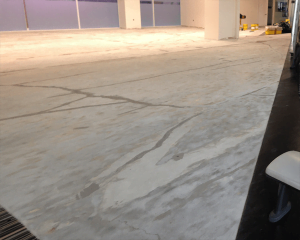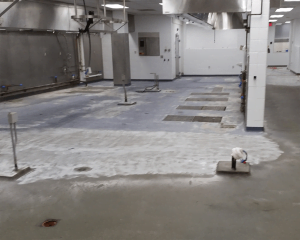Are you wondering what Missouri City TX concrete resurfacing is? Perhaps you’re wondering what the point of resurfacing your concrete floors is. Or perhaps you’re wondering if it’s worth going through with it? Will the process last longer than completely replacing the concrete slabs?

Hide the numerous repairs you’ve made to concrete by resurfacing it.
Concrete is one of the most durable building materials in existence. However, not even concrete can win against time. It’ll show damage after enduring the abuse from the changing seasons, constant vehicular and foot traffic, or the occasional chemical spillage. If you leave it for too long unattended, it’ll only grow worse.
Unless you recently got new concrete floors, usually they’ll gain sizeable cracks or holes that stretch across the surface. Sometimes they’ll have patches of noticeable discoloration or erosion caused by the elements. Other times, time ate away at the original design on the concrete, reducing it to an unintelligible art form of deformed patterns and faded colors. These are all signs of your concrete aging.
Resurfacing is a way to refinish your concrete floors. So long as it’s a type of concrete surface, you can resurface it. From concrete driveways to garages to concrete patios, you’ll be able to refresh its appearance, allowing it to last up to another 10 to 20 years.
Missouri City TX Concrete Resurfacing
If you’re noticing a lot of damage to your concrete floors, it may be time to resurface or replace them. By removing the top layer and pouring a new one over it, you can help your concrete floors last another couple of decades. It’s a simpler treatment than completely replacing your concrete floors and much cheaper.
While you’re at it, you can also update or add a decorative design to the concrete, giving the area more flair. From adding another layer of texture to adding an epoxy coating, you can change the boring look of plain concrete to something unique.

Add a decorative layer over your aging concrete!
Concrete Resurfacing is a Large Project
You need ample preparation before you can start a Missouri City TX concrete resurfacing project.
Before you can start pouring the new layer, you need first to clean the area. Professionals will usually power wash the concrete, getting rid of any dirt, oil, and grease stains. They’ll use chemicals to make sure sealers, coatings, or paints don’t remain on the surface. If there’s anything that’ll inhibit the new layer from sticking to the concrete, it won’t work as well.
After washing it, they can start assessing the extent of damages to the concrete. Usually, they’ll use a grinder or shot-blaster to remove the surface while “roughing” it up, which will allow the resurfacer to stick to the old layer. This process also levels out any unsound concrete hiding beneath the surface of your concrete floor. If there are any cracks or holes, they’ll patch them up.
Once you patch up the bottom layer, you can pour the new layer over it. The resurfacer is usually a type of polymer mix that can bind to the concrete beneath it and become a whole slab again. As it cures, you can add the decorative elements you want.
There are many options to choose from. Staining it will change the color of the concrete permanently, similar to staining a wood floor. Stamping it will add shapes to the floor, giving it a unique pattern. You can see this design choice around patio decks and pools.
After it cures, you can also add another layer of coating, like epoxy resin. This doubles as a sealer that will keep the concrete beneath it protected from any elements.
You can start walking on your resurfaced floors after 48 to 72 hours. It’ll take another day or two before you can drive your cars over it.
What condition should your concrete be in to resurface it?
Of course, resurfacing your concrete floors means it’s obviously taken a beating. However, resurfacing is an option sitting between two extremes. If your concrete’s condition falls outside of its zone, you should think of another way to repair or replace your floor.
Sometimes nature and time are kind to your concrete. That or your concrete floors happen to be mostly inside, so it’s not taking as much of a beating. At most, it’ll have a few cracks and holes, not enough to cause an issue nor wide enough to be concerning. If they’re no wider than a 1/4 inch, then you can repair them yourself.
These blemishes are too small to warrant resurfacing your entire floor. A quick repair job can keep it from expanding any further. However, the mixture for repairs is often a slightly different shade than your concrete. If you have an area with a dense amount of cracks to repair, you may be better off resurfacing it anyways since the area may become discolored.
On the other hand, sometimes your concrete floors are directly exposed to the outdoors. It’ll receive all the attention, and any damage is more obvious. If the damage is too severe, resurfacing may not work as well.
Since resurfacing is just laying on a new layer on top of the old concrete slab, it won’t be as helpful if there are any structural issues. Resurfacing may not work if your concrete is heaving, damaged from winter freezes, or has severe cracks. Resurfacing will not solve any underlying structural or soil problems. If you think your concrete is heavily damaged, you should consult a professional concrete contractor to assess the extent and magnitude of it before going forward with anything.
Deciding on if Resurfacing Your Concrete is Worth It

Contact Epoxy Technology Coatings about Missouri City TX Concrete Resurfacing.
Resurfacing your concrete is another way to breathe life back into it. It only works if its foundation is still sound and stable. However, if possible, it’s an excellent way to redesign the look of your concrete floors while making sure it lasts another 10 to 15 years.
Before you start working on your floors, you should consult a professional contractor. They can assess if there’s anything wrong with your concrete and can get the work done the right way the first time. Contact the experts at Epoxy Technology Coatings about any Missouri City TX concrete resurfacing projects and questions you may have.
Missouri City, TX Fun Facts:
- When it was first founded, Missouri City was the ideal commuter town.
- Missouri City has the first operating railroad in Texas.
- A railway once connected Missouri City to Los Angeles.
- For more fun facts, visit Missouri City’s official website.
